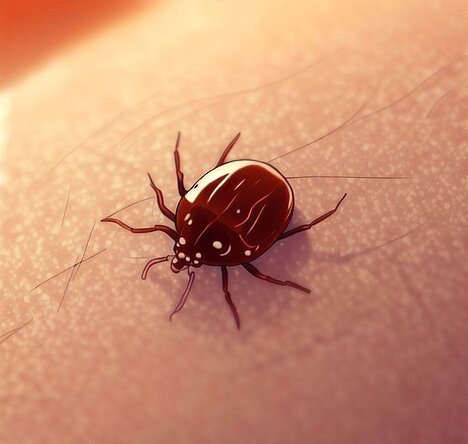Ticks

Ticks are annoying and dangerous parasites that can infect your dog with various diseases. In this article, you will learn how to protect your dog from ticks, how to recognize a tick bite and how to remove it correctly.
What are ticks and how do they get on dogs?
Ticks are arachnids and feed on the blood of their hosts. They have eight legs, a flattened body and a mouthparts with which they bore into the skin. Ticks are particularly active in spring and summer when temperatures rise above seven degrees Celsius. They lie in wait for passing animals or humans in tall grass, undergrowth or forest edges.
Ticks go through several stages of development: egg, larva, nymph and adult. In each stage they can infest a host and suck blood. The larvae and nymphs are very small and difficult to recognize. The adults are dark to reddish-brown in color, depending on the species, and sometimes have a shield or grain on their backs.
Why are ticks dangerous for dogs?
Ticks are not only annoying, but also dangerous for dogs. This is because they can transmit various pathogens that can have serious consequences for your dog's health. The most important diseases transmitted by ticks in dogs are
- Lyme disease: A bacterial infection that can lead to fever, joint inflammation, paralysis or nerve damage.
- Anaplasmosis: A bacterial infection that can lead to fever, loss of appetite, anemia or blood clotting disorders.
- Babesiosis: A parasitic infection that can lead to fever, anemia, jaundice or kidney failure.
- Ehrlichiosis: A bacterial infection that can lead to fever, anemia, nosebleeds or organ failure.
- TBE (tick-borne encephalitis): A viral infection that can lead to fever, headaches, vomiting or meningitis.
The symptoms of these diseases can vary from dog to dog and sometimes only appear weeks or months after the tick bite. It is therefore important to have your dog checked regularly by a vet and to watch out for changes in behavior or signs of discomfort.
How can you protect your dog from ticks?
The best way to protect your dog from ticks and the diseases associated with them is prevention. This includes the following measures:
- Avoid tick hotspots: If possible, you should avoid areas with your dog where there are lots of ticks. These include, for example, meadows, forests or the banks of bodies of water. If you do go for a walk there, keep your dog on a lead and stay on the paths.
- Check your dog after every walk: You should check your dog thoroughly for ticks after every outing. Areas with thin skin or little fur, such as the head, ears, neck or stomach, are particularly susceptible. If you discover a tick, remove it as quickly as possible using a suitable method (see below).
- Applyconsistent tick protection: There are several remedies that can protect your dog from a tick infestation. These include, for example, collars, spot-ons or tablets that you can buy from your vet. These products have a so-called repellent effect, which prevents the ticks from jumping onto the dog or biting into it. Make sure that you apply the repellent regularly and according to the manufacturer's instructions. Also note that some products are toxic to cats and should therefore not be used on dogs that live with cats.
How can you recognize and remove a tick bite from a dog?
Sometimes, despite all precautions, it can happen that your dog is bitten by a tick. If this happens, it is important that you recognize the tick bite on your dog and treat it correctly. You should follow the following steps:
- Recognize the tick bite: A tick bite on a dog is often difficult to notice, as the tick hides in the dense fur and the bite itself usually causes no pain. However, sometimes you can see a small bump or redness at the site of the bite. If you are unsure whether it is a tick, you can try to feel it carefully with your fingers or look at it with a magnifying glass.
- Remove the tick: If you have found a tick, you should remove it as quickly as possible. You will need a suitable tool for this, such as tick tweezers, a tick hook or a tick snare. You can buy these from pharmacies or pet shops. It is important that you grasp the tick as close to the skin as possible and pull it out slowly and straight. Avoid squeezing, twisting or tearing off the tick, as otherwise parts of the mouthparts could get stuck in the skin or pathogens could enter the bloodstream.
- Disinfect the wound: After you have removed the tick, you should clean the wound with a suitable disinfectant. This prevents infection and promotes healing. If you don't have any disinfectant to hand, you can also use a little alcohol or hydrogen peroxide.
- Observe your dog: In most cases, the wound heals quickly and without complications after a tick bite on a dog. Nevertheless, you should keep a close eye on your dog over the next few weeks and look out for possible symptoms of an infectious disease. These include, for example, fever, loss of appetite, tiredness, lameness or changes in the blood count. If you notice such signs or are unsure, you should visit your vet.
Ticks are a serious danger for dogs that should not be underestimated. However, with the right measures you can effectively protect your dog from a tick infestation and react correctly in an emergency.
The authors assume that a veterinarian should be consulted if an animal is ill and that medication should only be taken after consultation with a doctor or pharmacist. Only an individual examination can lead to a diagnosis and treatment decision.
We help you find the nearest vet → This way